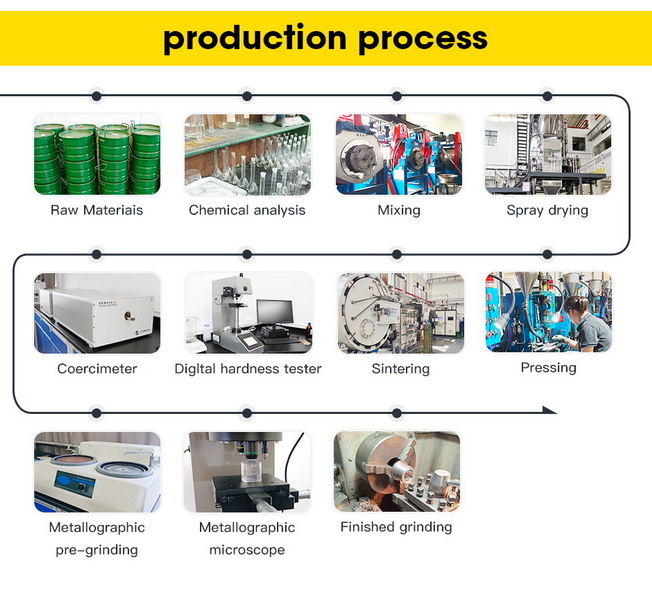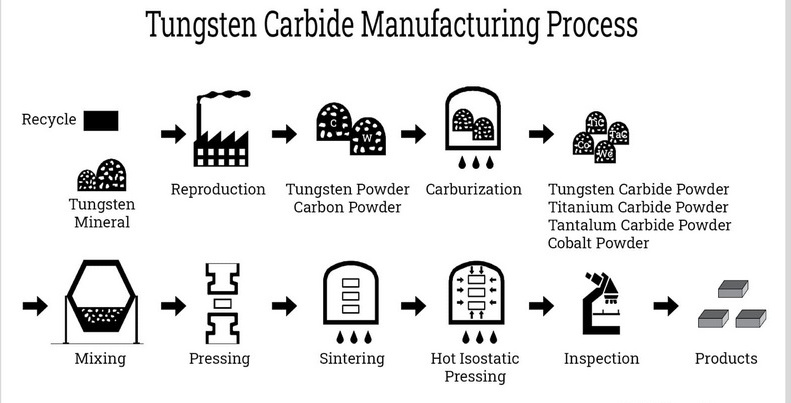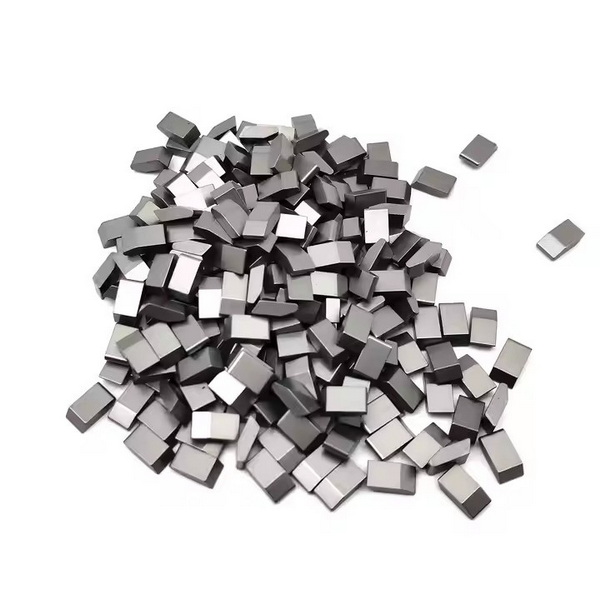Content Menu
● Understanding Tungsten Carbide
>> Properties of Tungsten Carbide
● Machining Processes
>> 1. Material Preparation
>> 2. Machining Techniques
>> 3. Tooling Considerations
>> 4. Heat Treatment
● Challenges in Machining Tungsten Carbide
>> Strategies for Overcoming Challenges
● Applications of Tungsten Carbide
>> 1. Cutting Tools
>> 2. Industrial Components
>> 3. Jewelry
>> 4. Medical Applications
>> 5. Automotive Industry
● Future Trends in Tungsten Carbide Machining
>> 1. Automation and Robotics
>> 2. Advanced Coatings
>> 3. Additive Manufacturing
>> 4. Sustainable Practices
● Conclusion
● FAQ
>> 1. What is tungsten carbide?
>> 2. Can all types of machines machine tungsten carbide?
>> 3. What are the common applications of tungsten carbide?
>> 4. How does heat treatment affect tungsten carbide?
>> 5. Why is diamond tooling recommended for machining tungsten carbide?
● Citations:
Tungsten carbide is a highly durable and hard material that has become essential in various industrial applications, particularly in cutting and drilling tools. This article explores the machining of tungsten carbide, detailing the processes involved, the challenges faced, and the applications of this remarkable material.

Understanding Tungsten Carbide
Tungsten carbide (WC) is a compound made from tungsten and carbon. It is known for its exceptional hardness, which is comparable to that of diamond, and its high density. These properties make tungsten carbide ideal for manufacturing cutting tools, industrial components, and wear-resistant parts.
Properties of Tungsten Carbide
- Hardness: Tungsten carbide has a microhardness of approximately 17,300 MPa, making it one of the hardest materials available.
- Density: It has a high density of around 15.6 g/cm³.
- Thermal Stability: Tungsten carbide can withstand high temperatures without losing its structural integrity.
- Chemical Resistance: It is resistant to corrosion and wear, making it suitable for harsh environments.
- Brittleness: Despite its hardness, tungsten carbide can be brittle, which poses challenges during machining.
Machining Processes
Machining tungsten carbide involves several critical steps to ensure precision and quality. The following sections outline the typical processes involved in machining tungsten carbide.
1. Material Preparation
Before machining, tungsten carbide is typically produced through a process that includes:
- Sintering: Tungsten powder is mixed with carbon and sintered at high temperatures to form solid tungsten carbide. This process usually occurs at temperatures ranging from 1,400 to 1,600 degrees Celsius.
- Grinding: The sintered material is ground into fine particles to prepare it for machining. The grinding process helps achieve the desired particle size and distribution.
2. Machining Techniques
Machining tungsten carbide requires specialized techniques due to its hardness. Common methods include:
- CNC Machining: Computer Numerical Control (CNC) machines are used for precise cutting and shaping. CNC machining allows for complex geometries and tight tolerances.
- Electrical Discharge Machining (EDM): This method uses electrical discharges to remove material and is particularly effective for intricate designs. EDM is ideal for creating complex shapes that would be difficult to achieve with traditional cutting methods.
- Grinding: Various grinding techniques (surface, internal, external) are employed to achieve desired dimensions and finishes. Grinding can also be used to refine the surface finish of tungsten carbide components.
3. Tooling Considerations
When machining tungsten carbide, choosing the right tools is crucial. Recommended tooling includes:
- Diamond-Coated Tools: These tools provide superior cutting performance due to their hardness. Diamond-coated tools are particularly effective for achieving smooth finishes on tungsten carbide surfaces.
- Carbide Inserts: Inserts made from carbide are commonly used in turning and milling operations. These inserts can withstand high temperatures and wear during machining.
4. Heat Treatment
Heat treatment may be applied post-machining to relieve internal stresses and enhance hardness. Common heat treatment processes include:
- Tempering: Heating the material to a specific temperature followed by controlled cooling helps reduce brittleness while maintaining hardness.
- Annealing: A process used to soften the material and improve machinability. Annealing can also help eliminate residual stresses from the machining process.

Challenges in Machining Tungsten Carbide
Machining tungsten carbide presents several challenges due to its extreme properties:
- Tool Wear: Tools can wear out quickly when machining tungsten carbide, requiring frequent replacements or reconditioning. The cost associated with tool wear can significantly impact production budgets.
- High Cutting Forces: The hardness of tungsten carbide results in high cutting forces that can lead to tool breakage if not managed properly. Operators must carefully monitor cutting parameters such as speed, feed rate, and depth of cut.
- Cost: The cost of machining tools and equipment suitable for tungsten carbide can be significantly higher than those used for softer materials. This includes both initial investment costs and ongoing maintenance expenses.
Strategies for Overcoming Challenges
To mitigate these challenges, manufacturers often employ several strategies:
1. Optimizing Cutting Parameters: Adjusting cutting speeds, feed rates, and depths of cut can help minimize tool wear while maximizing productivity.
2. Using Advanced Tool Materials: Investing in high-quality tooling materials such as polycrystalline diamond (PCD) or cubic boron nitride (CBN) can improve performance when machining tungsten carbide.
3. Implementing Coolant Systems: Using appropriate coolant or lubrication during machining can help reduce heat generation and prolong tool life.
4. Regular Maintenance: Regularly maintaining machinery and tools ensures optimal performance and reduces unexpected downtime.
Applications of Tungsten Carbide
Tungsten carbide's unique properties make it suitable for various applications across multiple industries:
1. Cutting Tools
Tungsten carbide is widely used in manufacturing cutting tools such as:
- Drills
- Milling cutters
- Taps
- Saw blades
These tools benefit from tungsten carbide's hardness and wear resistance, allowing them to cut through tough materials like steel and titanium effectively.
2. Industrial Components
In addition to cutting tools, tungsten carbide is utilized in various industrial components:
- Wear-resistant parts for mining equipment
- Nozzles for oil and gas drilling
- Components in aerospace applications
These components often experience extreme conditions, making tungsten carbide an ideal choice due to its durability.
3. Jewelry
Tungsten carbide's durability makes it a popular choice for jewelry, particularly wedding bands that require scratch resistance. Its ability to maintain a polished finish over time makes it an attractive option for consumers seeking long-lasting jewelry.
Tungsten Carbide Jewelry
4. Medical Applications
In recent years, tungsten carbide has found applications in the medical field as well:
- Surgical instruments
- Dental drills
- Orthopedic implants
The biocompatibility and strength of tungsten carbide make it suitable for use in medical devices that require precision and durability.
5. Automotive Industry
Tungsten carbide is also utilized in various automotive applications:
- Engine components
- Valve seats
- Transmission parts
The material's resistance to wear ensures longevity in high-stress environments typical of automotive applications.
Future Trends in Tungsten Carbide Machining
As technology continues to advance, so too does the field of tungsten carbide machining. Several trends are emerging that may shape the future of this industry:
1. Automation and Robotics
The integration of automation technologies into machining processes can enhance efficiency while reducing human error. Robotics can assist with repetitive tasks such as loading/unloading workpieces or performing secondary operations on machined parts.
2. Advanced Coatings
Developments in coating technologies may lead to improved performance of cutting tools used on tungsten carbide materials. Coatings such as titanium nitride (TiN) or aluminum oxide (Al2O3) can enhance tool life by providing additional protection against wear.
3. Additive Manufacturing
While traditionally not associated with additive manufacturing (3D printing), research into using tungsten carbide powders in additive processes may open new avenues for creating complex geometries that were previously difficult or impossible with conventional methods.
4. Sustainable Practices
As industries move toward more sustainable practices, there will likely be an increased focus on recycling tungsten carbide materials from worn-out tools or components rather than disposing of them entirely.
Conclusion
Machining tungsten carbide is a complex process that requires specialized knowledge and equipment due to its extreme hardness and durability. Understanding the various machining techniques, tooling requirements, challenges involved, as well as emerging trends is crucial for achieving high-quality results in this field. With its wide range of applications across industries such as manufacturing, aerospace, jewelry-making, medical devices, and automotive engineering, tungsten carbide continues to be a valuable material in modern engineering.

FAQ
1. What is tungsten carbide?
Tungsten carbide is a compound made from tungsten and carbon known for its exceptional hardness and durability.
2. Can all types of machines machine tungsten carbide?
Not all machines can effectively machine tungsten carbide; specialized CNC machines or EDM are typically required due to the material's hardness.
3. What are the common applications of tungsten carbide?
Common applications include cutting tools, industrial components, jewelry, medical devices, and automotive parts.
4. How does heat treatment affect tungsten carbide?
Heat treatment can relieve internal stresses in tungsten carbide and enhance its hardness while improving overall performance in machining applications.
5. Why is diamond tooling recommended for machining tungsten carbide?
Diamond tooling is recommended because it provides superior cutting performance due to its hardness, which allows it to effectively cut through tough materials like tungsten carbide.
Citations:
[1] https://www.carbide-products.com/blog/tungsten-carbide-machining-process/
[2] https://shop.machinemfg.com/understanding-tungsten-properties-applications-and-stability/
[3] https://todaysmachiningworld.com/magazine/how-it-works-making-tungsten-carbide-cutting-tools/
[4] https://www.refractorymetal.org/tungsten-carbide-uses-properties.html
[5] https://www.carbide-part.com/blog/tungsten-carbide-machining-process/
[6] https://www.tungco.com/insights/blog/5-tungsten-carbide-applications/
[7] https://patents.google.com/patent/US4008090A/en
[8] https://www.sollex.se/en/blog/post/about-cemented-tungsten-carbide-applications-part-1
















